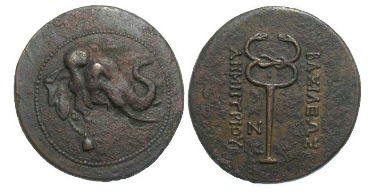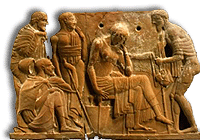 |
 |
WE HAVE NOW MOVED OUR INVENTORY OF ANCIENT AND
www.vcoins.com/calgarycoin
|
 Macedonian
Kingdom, Demetrios Poliorketes, 306 to 283 BC. Silver tetradrachm of
the Alexander style (RARE TYPE).
While a lot of Alexander style tetradrachms were struck during this period, most of them were in the name of Alexander and it is rare to fine one struck in the name of Demetrios Poliorketes.
SOLD
Order
# 3111
|
 Indo-Greek, Bactria, Demetrios I,
190 to 171 BC. Bronze Hemiobol.
SOLD
Order
# 3833
|
 Kingdom
of Galatia. King Amyntas,
ca. 36 to 24 BC. AE 23. Galatia was a small kingdom in Asia Minor. It was
founded by the Celtic tribes, Tectosages, Tolistobogii and Trocmi in
the 3rd cent. BC. It was given it's independance
as a kingdom by Pompey the Great in 64 BC, and then lost it's
independance when it was absorbed into the Roman Empire as a Province
about 24 BC. Amyntas was the last King of Galatia.
SOLD
Order
# 3649
|
 Pergamene
Kingdom. Attalus I, ca. 241 to 197 BC. AR tetradrachm in the name of
Philetairos.
Most silver tetradrachms of the Pergamene Kingdom
are inscribed with
the portrait and name of Philetairos who was the first King of the
Pergamene Kingdom (282-263 BC).
SOLD
Order
# 3834
|
ALL PRICES ARE IN US DOLLARS
CANADIAN ORDERS MUST ADD GST/HST TO ALL PRICES
Next page of Greek Coins
Top of Page


MACEDONIAN KINGDOMThe early coinage of Macedonia is fairly complex and can be divided into two parts. The first are those coins issued under the Macedonian cities, making no reference to any particular king. The second are the coins issued in the name of Macedonian Kings, often not naming any particular city. The Kingdom was first established by Alexander I in 495 BC, and lasted until the death of Perseus in 168 BC. At first it was a relatively minor kingdom, but under Philip II (359-336 BC) it became much more powerful with the borders expanding to include most of Greece. Under Philip II's son Alexander III (the Great), the Macedonian Kingdom became the most powerful that the world had seen to that point, expanding the borders east into India and south to Egypt, including most of the Middle East. Unfortunately, with Alexander's death the kingdom quickly disintegrated, again becoming a relatively minor power in the region. Philip IIIPhilip III was the feeble-minded half-brother of Alexander the Great, who on Alexander's death, Alexander's general thrust onto the throne as a puppet ruler they could control while they figured out how to divide up the Empire. After six years on the throne, Olympias (Alexander's mother) murdered him. KINGDOM OF THRACELYSIMACHOS ILysimachos was one of Alexander the Great's body guards. During the confusion that followed Alexander's death he was appointed governor of Thrace and in 305 BC assumed the title of King and began a military expansion extending from Thrace into much of Asia Minor. A harsh and unpopular ruler, he was probably not greatly missed when he was killed at the battle of Korupendion in 281 BC, and his kingdom was absorbed into the Seleukid Empire. SELEUKID KINGDOMSoon after the death of Alexander the Great, Seleukid I (one of Alexander's generals) was given the governorship of "Babylon" (probably everything between Syria and India). About 316 BC he lost control to Antigonos the One-eyed but escaped to Egypt. In 312 BC he regained control and in 305 BC declared himself King, establishing the Seleukid Empire. In 281 BC he defeated Lysimachos, extending his territory to include all of Alexander's realm except for Egypt. Following an extended period of civil war, the Seleukids called upon the Armenian King Tigranes to help them restore order, which he did by defeating Philip Philadelphos in 83 BC. Once order was restored he stayed to rule Syria for 14 years, until he was defeated by the Roman general Lucullus, in 69 BC. The Seleukid empire was to last for almost 250 years but gradually declined in power. Baktria and Parthia broke away during the mid-3rd century BC and in 190 BC the Seleukids suffered a major defeat at the hands of the Romans, losing control of Asia Minor, leaving them only with Syria and the surrounding area. The Empire came to an end in 64 BC when it was defeated by a Roman army under the command of Pompey the Great. PTOLEMAIC KINGDOMFollowing Alexander the Great's death in 323 BC, general Ptolemy was appointed as satrap of Egypt where he served as an able ruler and consolidated his power. In 305 BC he took the title of King, establishing a Dynasty that lasted for 275 years and at its height control all of Egypt as well as parts of Palestine, Syria, Phonecia, and the island of Cyprus. Ptolemain's rule ended when Cleopatra VII allied herself with Mark Antony and committed suicide following their loss at the battle of Actium in 31 BC. |
| Top of Page Copyright © 1997-2005 R & T Enterprises Ltd. |
 |